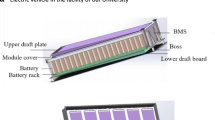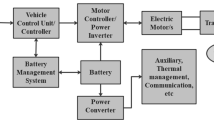Abstract
With the rapid development of pure electric vehicles, how to improve the range has become the focus of research. Due to the large shell mass of the battery pack shell (BPE), it is necessary to optimize its structure in turn. In this paper, the BPE model was reconstructed by improving the upper shell material and adding reinforcements following the direction of the leaf vein fibers of the Magnolia Grandiflora. A quasi-Monte Carlo method based on Sobol sequences and a Latin hypercube design with variance sensitivity analysis was used to determine the seven design variables. The 122 data sets were trained and predicted using the basic gradient descent algorithm combined with the conjugate direction method, and the predictions were compared with static mechanical simulations for sharp cornering conditions on bumpy roads. The results showed that the BPE weight reduction ratio was 19.5%, and the maximum stress reduction ratio was 27.49%, and the displacement reduction ratio was 29.29% respectively, which satisfied the material requirements. It had a 20.88% increase in first-order mode frequency, which effectively prevented resonance.





















Similar content being viewed by others
References
Zhili, D.; Boqiang, L.; Chunxu, G.: Development path of electric vehicles in China under environmental and energy security constraints. Resour. Conserv. Recycl. 143, 17–26 (2019). https://doi.org/10.1016/j.resconrec.2018.12.007
Wen, Z.; Li, H.; Zhang, X.; Chi Kin Lee, J.; Xu, C.: Low-carbon policy options and scenario analysis on CO2 itigation potential in China’s transportation sector. Greenh. Gases Sci. Technol. 7(1), 40–52 (2017). https://doi.org/10.1002/ghg.1623
Mayyas, A.; Omar, M.; Hayajneh, M.; Mayyas, A.R.: Vehicle’s lightweight design vs. electrification from life cycle assessment perspective. J. Clean. Prod. 167, 687–701 (2017). https://doi.org/10.1016/j.jclepro
Mossali, E.; Gentilini, L.; Merati, G.; Colledani, M.: Methodology and application of electric vehicles battery packs redesign for circular economy. Procedia CIRP 91, 747–751 (2020). https://doi.org/10.1016/J.PROCIR.2020.01.139
Ribu, L.I.; Hailin, W.A.N.G.; Dongsheng, W.U., et al.: A lightweight technology review on battery pack of electrical vehicles. Automobile Parts 07, 101–107 (2019). https://doi.org/10.19466/j.cnki.1674-1986.2019.07.026
Xiong, Y.; Pan, Y.; Wu, L.; Liu, B.: Effective weight-reduction-and crashworthiness-analysis of a vehicle’s battery-pack system via orthogonal experimental design and response surface methodology. Eng. Fail. Anal. 128, 105635 (2021). https://doi.org/10.1016/j.engfailanal.2021.105635
Zuo, S.; Yin, B.; Xu, Y.; Wu, X.; Li, Y.; Wang, J.: A simplified method of soft connected battery module for finite element method model of battery pack. Int. J. Energy Res. 45(7), 10546–10561 (2021). https://doi.org/10.1002/er.6543
Xia, B.; Liu, F.; Xu, C., et al.: Experimental and simulation modal analysis of a prismatic battery module. Energies 13(8), 2046 (2020). https://doi.org/10.3390/en13082046
Uerlich, R.; Ambikakumari Sanalkumar, K.; Bokelmann, T.; Vietor, T.: Finite element analysis considering packaging efficiency of innovative battery pack designs. Int. J. Crashworthiness 25(6), 664–679 (2020). https://doi.org/10.1080/13588265.2019.1632545
Wierzbicki, T.; Sahraei, E.: Homogenized mechanical properties for the jellyroll of cylindrical Lithium-ion cells. J. Power Sources 241, 467–476 (2013). https://doi.org/10.1016/j.jpowsour.2013.04.135
Hooper, J.M.; Marco, J.: Experimental modal analysis of lithium-ion pouch cells. J. Power Sources 285, 247–259 (2015). https://doi.org/10.1016/j.jpowsour.2015.03.098
Niu, X.; Garg, A.; Goyal, A.; Simeone, A.; Bao, N.; Zhang, J.; Peng, X.: A coupled electrochemical-mechanical performance evaluation for safety design of lithium-ion batteries in electric vehicles: an integrated cell and system level approach. J. Clean. Prod. 222, 633–645 (2019). https://doi.org/10.1016/j.jclepro.2019.03.065
Pan, Y.; Xiong, Y.; Dai, W.; Diao, K.; Wu, L.; Wang, J.: Crush and crash analysis of an automotive battery-pack enclosure for lightweight design. Int. J. Crashworthiness 27(2), 500–509 (2022). https://doi.org/10.1080/13588265.2020.1812253
Shui, L.; Chen, F.; Garg, A.; Peng, X.; Bao, N.; Zhang, J.: Design optimization of battery pack enclosure for electric vehicle. Struct. Multidiscip. Optim. 58(1), 331–347 (2018). https://doi.org/10.1007/s00158-018-1901-y
Li, W.; Garg, A.; Xiao, M.; Peng, X.; Le Phung, M.L.; Tran, V.M.; Gao, L.: Intelligent optimization methodology of battery pack for electric vehicles: a multidisciplinary perspective. Int. J. Energy Res. 44(12), 9686–9706 (2020). https://doi.org/10.1002/er.5600
Li, Y.: Multi-objective optimization design for battery pack of electric vehicle based on neural network of radial basis function (RBF). J. Phys. Conf. Ser. 1684(1), 012156 (2020). https://doi.org/10.1088/1742-6596/1684/1/012156
Shahin, M.E.; Yun, L.; Chin, C.M.M.; Gao, L.; Wang, C.T.; Niu, X.; Garg, A.: An application of genetic programming for lithium-ion battery pack enclosure design: modelling of mass, minimum natural frequency and maximum deformation case. In: IOP Conference Series: Earth and Environmental Science, vol. 268, No. 1, p. 012065. IOP Publishing (2019). https://doi.org/10.1088/1755-1315/268/1/012065
Cheng, W.W.: Research on the lightweighting of electric vehicle battery pack structure based on precision casting technology. Master's thesis, Hefei University of Technology (2019). https://doi.org/10.27101/d.cnki.ghfgu.2019.000372
Shaoqiang, X.; Weiwei, L.; Lin, L.: Research and optimization on crashworthiness of self-similar bionic multi-cell thin-walled tube. Mech. Sci. Technol. Aerosp. Eng. (2022). https://doi.org/10.13433/j.cnki.1003-8728.20200517
Kexian, B.; Yan, K.; Bin, Y.; Kangping, F.; Zhipeng, H.; Yuepeng, X.; Kong, X.: Mass modeling and sensitivity analysis of lightweight hydraulic actuators for foot-operated robots. J. Mech. Eng. 24, 39–48+82 (2021). https://doi.org/10.3901/JME.2021.24.039
Xiong, G.; Wu, X.; Qiu, F.-L.; Zuomi, Dong: Sensitivity analysis and optimal design of hydraulic static pile driver press box structure. Mod. Manuf. Eng. 01, 129–133 (2016). https://doi.org/10.16731/j.cnki.1671-3133.2016.01.025
Wei, S.; Li, Y.; Gao, X.; Lee, K.Y.; Sun, L.: Multi-stage sensitivity analysis of distributed energy systems: a variance-based sobol method. J. Mod. Power Syst. Clean Energy 8(5), 895–905 (2020). https://doi.org/10.35833/MPCE.2020.000134
Chen, T.C.; Han, D.J.; Au, F.T.; Tham, L.G.: Acceleration of Levenberg-Marquardt training of neural networks with variable decay rate. In: Proceedings of the International Joint Conference on Neural Networks, 2003. vol. 3, pp. 1873–1878. IEEE. (2003)
Bengio, Y.: Practical recommendations for gradient-based training of deep architectures. In: Neural Networks: Tricks of the Trade, pp. 437–478. Springer, Berlin, Heidelberg (2012)
Qiang, H.U.O.; Xi, L.I.U.; Chen, L.J.; Wu, Y.H.; Wu, H.Y.; Xie, J.P.; Qiu, G.Z.: Treatment of backwater in bauxite flotation plant and optimization by using Box-Behnken design. Trans. Nonferrous Met. Soc. China 29(4), 821–830 (2019). https://doi.org/10.1016/S1003-6326(19)64992-7
Funding
This study was funded by [1.Open Fund project of Transportation Industry Key Laboratory of Vehicle Testing, Diagnosis and Maintenance Technology: “Structural optimization design of Vehicle Power Battery Pack”,JTZL2004; 2.A Project of Shandong Province Higher Educational Science and Technology Program, J18KA006].
Author information
Authors and Affiliations
Corresponding author
Ethics declarations
Conflict of interest
The authors declare that they have no conflict of interest.
Rights and permissions
Springer Nature or its licensor (e.g. a society or other partner) holds exclusive rights to this article under a publishing agreement with the author(s) or other rightsholder(s); author self-archiving of the accepted manuscript version of this article is solely governed by the terms of such publishing agreement and applicable law.
About this article
Cite this article
Gao, Y., Liu, N., Cui, C. et al. Design of Bionic Structure Parameters of Pure EV BPE Based on Proportional Conjugate Gradient Algorithm. Arab J Sci Eng 49, 1461–1477 (2024). https://doi.org/10.1007/s13369-023-07884-9
Received:
Accepted:
Published:
Issue Date:
DOI: https://doi.org/10.1007/s13369-023-07884-9




